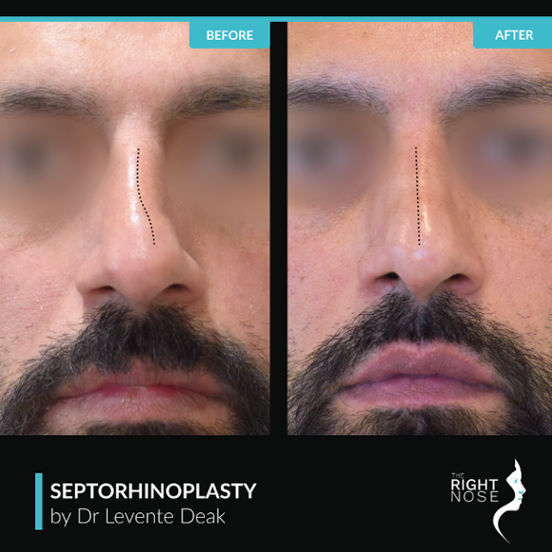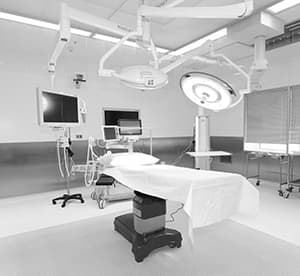Septoplasty In Dubai
Deviated Septum Surgery
Septoplasty In Dubai
Deviated Septum Surgery
Septoplasty
The nose is partitioned in the middle by the nasal septum, dividing it into two nostrils. The nasal septum is made of cartilage and bone. Sometimes, due to injury or simply through natural growth, it may be bent, buckled or deviated to one (or both) sides, causing airway blockage and compromising normal sinus ventilation.
Septoplasty fixes a crooked septum, improving airflow and breathing. It’s usually done as a day surgery, with swelling lasting a few days and full recovery taking up to three months.

How is the Septoplasty performed?
Septoplasty is performed under light narcosis. Since we are using the keyhole surgical technique, only a small cut is made inside the nose without the need for external scars. During the surgery, we will reshape the cartilage in order to have free airflow on both sides.
After the surgery, we will insert a small silicone sheet inside your nose for 5 days to protect the newly created septum. Since we are using a minimally invasive method, nasal packing is not necessary. Recovery is no more than 3 days.
Septoplasty takes about 30-60 minutes, depending on the severity of septal deviation. There are no black eyes after the surgery, and the outward shape of the nose is not altered.
Septoplasty is commonly combined with rhinoplasty, which is a cosmetic procedure aimed at improving the shape of your nose. With the availability of the finest instrumentation and the high skills of our surgeon, you can leave the hospital on the same day.

Finding skilled surgeons for septoplasty in Dubai for nasal obstruction relief is easy now!
Contact Dr Levente Deak for septoplasty in Dubai and find relief from nasal blockage through effective deviated septum surgery.
Before the Septoplasty Surgery In Dubai
Our deviated septum surgery is tailored for improved nasal function. However, we advise that you stop smoking as soon as possible and avoid extensive sun exposure. Also, there are certain foods to be avoided, as they affect the development of blood clotting, like Aspirin, Vitamin E, St John’s wort, dietary supplement, Otrivine, NSAID, garlic, ginseng, at least 2 weeks prior to the surgery.
Also, any facial injectable material you might have done must be shared with us.

In the Hospital - the first six hours
You may wake up with some packing in your nose to stop any bleeding. If present, this should be left alone and will be removed by your doctor when appropriate.
- Do not blow your nose for 7 days.
- If you experience any pain, please call the nurse, and the pain can easily be managed by regular painkiller
The first week at home
- You may get a blood stain / pinkish discharge for a few days. The bleeding gets less and less as the days go by, but there may still be a little “spotting” on your handkerchief even up to a few weeks after the surgery. This is common.
- Avoid all moderate and heavy physical activity, including sports, for ten days after the operation. Avoid bending down to pick things up, especially heavy weights. Active sport should not be commenced for two weeks after the surgery, and even then, it should be increased gradually
- It is normal for the nose to feel blocked for several days and up to two weeks after the surgery as the swelling settles.
- You must irrigate your nose frequently, “douching” at least 3 times a day with the saline solution provided to clear away scabs and crusting which occur after the operation.
- Avoid smoky and dusty atmospheres if possible, as this may irritate the nasal lining.
- Avoid very hot baths and showers.
- If you take aspirin, please discuss this with Dr Levente, your septoplasty surgeon, as you may need to avoid taking it since it could potentially increase the risk of nasal bleeding.
- It is advised not to drive for 48 hours because of the effects of the general anaesthetic.
- You should not plan to go away on holiday for at least two weeks after your operation.
Dr Levente Deak is a highly renowned ENT and septoplasty surgeon who addresses nasal congestion with deviated septum surgery options.
Find relief from nasal blockage through effective deviated septum surgery!
FAQs
Septoplasty surgery and deviated nasal septum surgery are interchangeable terms referring to the same procedure aimed at correcting a deviated nasal septum to improve nasal airflow and alleviate symptoms such as congestion. Both procedures involve straightening the nasal septum, typically performed by a septoplasty surgeon.
Before septoplasty surgery, you will consult with a septoplasty surgeon to discuss your symptoms and treatment goals. After the procedure, you may experience improved nasal breathing, reduced congestion, and enhanced overall nasal function. However, individual results may vary, and it’s essential to follow post-operative care instructions provided by your surgeon.
Deviated septum treatment often involves septoplasty surgery, a procedure performed by a skilled septoplasty surgeon to straighten the nasal septum and improve airflow. Septoplasty surgery is recommended when symptoms of nasal obstruction, difficulty breathing, or chronic sinus issues.
During septoplasty surgery, the septoplasty surgeon makes an incision inside the nostrils to access the nasal septum. The deviated portions of the septum are then straightened or removed, allowing for improved airflow and nasal function. The procedure is typically performed under local or general anaesthesia, and recovery time varies depending on the individual and the extent of surgery.
When selecting a septoplasty surgeon for deviated septum treatment, consider factors such as their experience, expertise in nasal surgery, patient reviews, and the quality of care provided. It’s essential to schedule a consultation with potential surgeons to discuss your concerns, treatment options, and expected outcomes before proceeding with septoplasty surgery.





